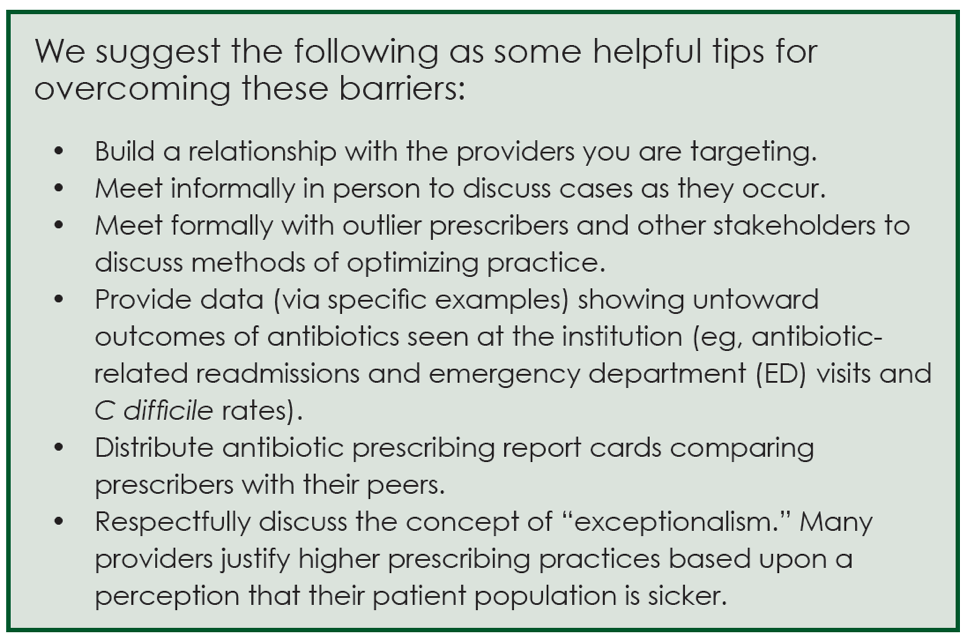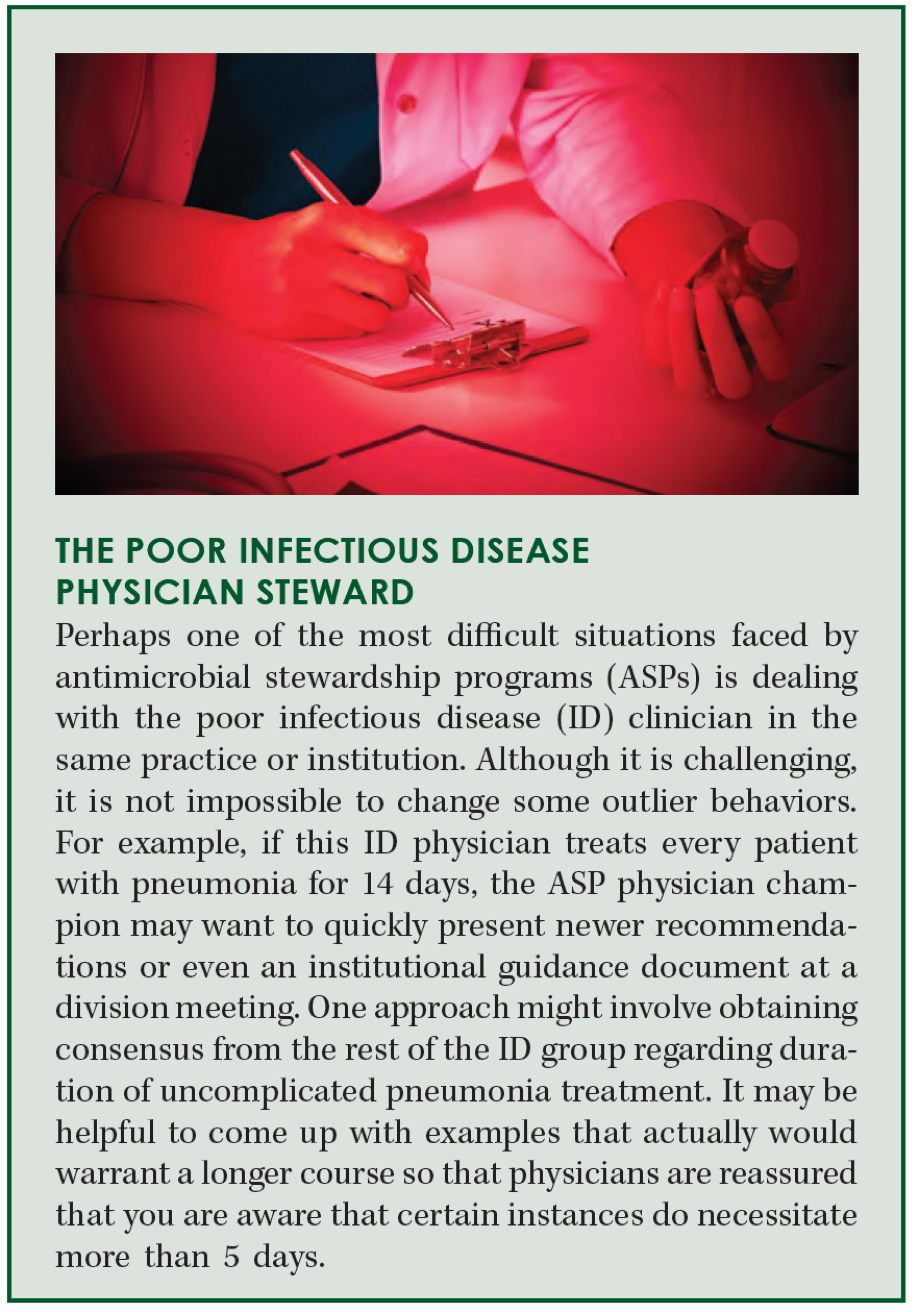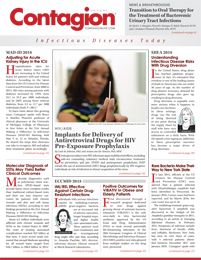Managing Reluctant Antibiotic Stewards: Advice From an ID Physician and an ID Pharmacist
Although challenging, it is not impossible to change some outlier behaviors.
BACKGROUND
The Infectious Diseases Society of America, in addition to organizations such as The Joint Commission and the Centers for Disease Control and Prevention, has emphasized the critical need for antimicrobial stewardship programs (ASPs) across various health care settings in the United States.1-3 Recommendations published by these organizations provide guidance for methods of conducting ASPs. Members of ASPs often have the necessary knowledge to back up specific recommendations but, when faced with sociobehavioral barriers, may not be equipped with the resources or skills that will alter prescribing habits. In addition, although a great deal of data exist on ways to optimize antibiotic usage, every institution has its own nuanced antibiotic practice patterns that require a tailored approach. Little guidance is available to support ASPs when they encounter difficult situations, such as a “reluctant steward.” As an infectious disease (ID) physician and an ID pharmacist, we aim to provide suggestions to help programs overcome common barriers.
OUTLIER OR RELUCTANT ANTIBIOTIC PRESCRIBERS
At some point, ASP members will inevitably encounter an outlier antibiotic prescriber. Reasons for outlier prescribing are complex, multifactorial, and not necessarily a result of a knowledge deficit. A systematic review published by Teixeira and colleagues showed that attitudes such as complacency or fear were the 2 most influential intrinsic influencers on antibiotic prescribing. Extrinsic influencers greatly varied, including patient-related factors such as illness, as well as health care—related factors such as time pressure and following policies and guidelines.4 A prescriber may have many more years of experience compared with the ASP members and has “always done it this way” or perhaps was “burned” once or twice, leading to concern of undertreating or even fear of altering a good track record of favorable outcomes. Providers may be more afraid of the risk of undertreating than the societal or patient risk of receiving unnecessary antibiotics.5 For example, provider X opted not to treat a case of sinusitis 20 years prior that led to a cerebral abscess. Although this provider would ideally remember all the sinusitis cases that did not lead to that poor outcome, it is difficult to forget this single situation and, therefore, their threshold for prescribing antibiotics is lower for this type of infection. Another relevant example is a surgeon with excellent surgical site infection (SSI) outcomes who strongly attributes that it is, in part, because of a practice of using a long duration of postoperative antibiotics. The fear of stopping this practice and having 1 patient develop an SSI is too great, so the surgeon continues this practice. There are many other reasons providers might overprescribe.
It is important to reassure providers that the ASP team is working alongside them to improve patient care and not “policing” antibiotic practice. Communicating about the following themes may be of great benefit: Many antibiotics have lost effectiveness; Clostridium difficile infection is on the rise; antibiotics alter gut flora, increasing the likelihood of a subsequent multidrug-resistant infection; and most patients who develop an infection will do so regardless of an initially prolonged duration of antibiotics. ASPs need to assume the role of convincing providers that it’s time to change our perception of antibiotics; the risk—benefit balance has become more important than ever.
WHAT DOES THE SOCIOBEHAVIORAL EFFECT HAVE TO DO WITH ANTIBIOTICS?
Antimicrobial stewardship studies rarely consider sociobehavioral determinants in the evaluation of antibiotic prescribing interventions. Charani et al performed a systematic review and showed that many studies evaluating behavior change on antibiotic prescribing were not of high quality and not scientific. The authors of this review concluded that more research is needed in terms of well-designed interventions that assess prescribing behavior.6 Results from qualitative studies have shown that behavioral determinants significantly affected antibiotic prescribing.7,8 The DUMAS study findings revealed that a behavioral approach resulted in sustained appropriateness of antibiotic prescribing. This study used a participatory approach based on behavioral theory and maintained prescriber autonomy, essentially allowing prescribers to choose how they wanted to improve their practices and leading to a feeling of ownership.9
STRATEGIES TO WORK WITH OUTLIER PRESCRIBERS
Internal institutional data and published evidence provide leverage to make a change with outlier prescribers. Although educational interventions are important, their use may be limited because results may not be sustained over time, thereby requiring frequent and repeated interventions.

Many prescribers think that they themselves are not the problem or even that their patients are different, warranting longer antibiotic durations and/or broader spectrum agents.10 Regardless of the reasons, the ASP team should remember that providers truly want what is best for their patients; they want good outcomes and happy patients and families. This attitude will help establish a healthy relationship between the ASP and other providers.
EXAMPLES OF GOOD TACTIC
Criticizing prescriber practice leads to unsuccessful interventions and mistrust between the ASP and the primary team. It is important to remember that the liability and responsibility of the patient ultimately lie on the primary team, not the ASP. Therefore, statements about this when discussing cases can be helpful in gaining credibility. Reassure the teams that it is ultimately their decision but that you would like to provide guidance for de-escalation or limiting the duration based on the patient’s clinical course and evidence-based practice.
Tread lightly and pick your battles. This gives the team a sense of security and co-ownership when it comes to antibiotic decision making. For example, you might say, “I’m calling to discuss your patient John Smith. It seems that you are treating pneumonia, correct? I realize this patient is very complicated; however, his respiratory cultures have been negative, so perhaps we can de-escalate the vancomycin and continue cefepime. Methicillin-resistant Staphylococcus aureus [MRSA] tends to grow very easily. If he had MRSA pneumonia, we would’ve seen growth by now. Also, I’m confirming you are OK with the standard 5-day course of antibiotics, as long as the patient clinically improves.”
In terms of antibiotic discontinuation recommendations for patients who are not being discharged, it can be beneficial to remind the team that the patient will continue to be monitored and sepsis alerts are now very sensitive; therefore, if the patient develops a new fever or leukocytosis, restarting antibiotics at that point is feasible. In addition, focusing efforts on overall antibiotic prescribing, not just de-escalation, can help the ASP gain creditability. It is comforting for primary teams to know that the ASP may call them to escalate antibiotics or recommend infectious disease physician consultation when the case is outside their scope. Again, these are reminders to the primary team that the ASP aims to assist the team, not police their antibiotics.
PICK THE LOW-HANGING FRUIT
In an ideal world, all ASP recommendations would be accepted and patients would be de-escalated consistently. However, we recommend sticking to the low-hanging fruit to increase the chance of acceptance. Certain indications essentially never require antibiotic therapy and can be easy targets for ASPs. Asymptomatic bacteriuria (ASB) is perhaps one of the most important areas to target, because ample data exist to support avoiding antibiotics in most patient populations. The difficulty with ASB involves the “gray zone,” which generally encompasses patients who are nonverbal, are confused, and have neurological deficits. The primary team may defend the decision to start antibiotics by stating that it is difficult to assess for symptoms of urinary tract infection. In most cases, you can recommend a “watch and wait” approach, in which antibiotics are withheld and the patient is watched for 24 to 48 hours. However, to truly target the ASB problem, work with your ED colleagues to stop ordering unnecessary urine tests (including urinalysis and urine cultures).11
In the outpatient setting, prescribing for respiratory illnesses represents the most common reason a patient receives an antibiotic inappropriately. Working with the informatics department to obtain reports of outpatients who had coded bronchitis or cold and received antibiotics can be a good tactic if outpatient stewardship is an institutional goal. One effective, low-cost approach to outpatient stewardship is to encourage the use of a commitment poster. A study by Meeker and colleagues showed that if a provider signs a poster describing the commitment to using antibiotics just when they will provide benefit and places it in the patient exam rooms, prescribing for respiratory infections improves.12 This likely reflects the providers’ interest in being consistent with their previous commitments.
INVOLVING ADMINISTRATION AND LEADERSHIP
Support from clinical leadership (ie, the chief medical officer) and administration are critical in resolving situations that threaten patient safety.1-3 Establishing these connections will help in scenarios in which the “difficult provider” is not interested in discussing opportunities for practice change. Last, although a written statement from the administration is important, it is insufficient for fostering a valuable relationship. Creating an open dialogue between the ASP and leadership is crucial for optimizing institutional antimicrobial practice. To make a broader change, ASPs need to engage senior colleagues and division heads outside of infectious diseases.1,3,8
CONCLUSION
It is important to recognize that some situations are impossible to rectify or will take up too much time to make the time invested worthwhile. Focus on the majority of providers who will accept recommendations and work collaboratively. Pick your battles with those who are unwilling to change their practices, recognizing that if patients are being harmed, leadership may have to step in. Finally, every facility has its own priorities related to optimal antibiotic prescribing. Some institutions may want to focus on optimal treatment of community-acquired pneumonia rather than skin and soft tissue infections. Using prescribing data for action will help identify where stewardship interventions will likely have the most impact.

Dr. Hicks is the director of the Office of Antibiotic Stewardship in the Division of Healthcare Quality Promotion at the National Center for Emerging and Zoonotic Infectious Diseases, US Centers for Disease Control and Prevention. She is also a captain in the US Public Health Service. Dr. Hicks attended the Philadelphia College of Osteopathic Medicine and completed her internal medicine residency and chief medicine residency at the University of Connecticut and an infectious diseases fellowship at Brown University.
Dr. Rose received a PharmD at Massachusetts College of Pharmacy & Health Sciences, completed a PGY-1 pharmacy practice residency at UMassMemorial Health Care, and a PGY-2 infectious diseases pharmacotherapy residency at The Brooklyn Hospital Center. She is currently the co-director of the Antimicrobial Stewardship Program at Cooper University Hospital in Camden, New Jersey, and is as an adjunct professor at Cooper Medical School of Rowan University and University of the Sciences.
References
- Barlam TF, Cosgrove SE, Abbo LM, et al. Executive summary: Implementing an Antibiotic Stewardship Program: Guidelines by the Infectious Diseases Society of America and the Society for Healthcare Epidemiology of America. Clin Infect Dis. 2016;62(10):e51-e77. doi: 10.1093/cid/ciw217.
- Joint Commission on Hospital Accreditation. Approved: new antimicrobial stewardship standard. Jt Comm Perspect. 2016;36(7);1,3,4,8.
- Centers for Disease Control and Prevention. Core elements of hospital antibiotic stewardship programs. CDC website. cdc.gov/antibiotic-use/healthcare/implementation/core-elements.html. Updated February 23, 2017. Accessed June 1, 2018.
- Teixeira Rodrigues A, Roque F, Falcao A, Figueiras A, Herdeiro MT. Understanding physician antibiotic prescribing behaviour: a systematic review of qualitative studies. Int J Antimicrob Agents. 2013;41(3):203-212. doi: 10.1016/j.ijantimicag.2012.09.003.
- May L, Gudger G, Armstrong P, et al. Multisite exploration of clinical decision-making for antibiotic use by emergency medicine providers using quantitative and qualitative methods. Infect Control Hosp Epidemiol. 2014;35(9):1114-1125. doi: 10.1086/677637.
- Charani E, Edwards R, Sevdalis N, et al. Behavior change strategies to influence antimicrobial prescribing in acute care: a systematic review. Clin Infect Dis. 2011;53(7):651-662. doi: 10.1093/cid/cir445.
- Charani E, Castro-Sanchez E, Sevdalis N, et al. Understanding the determinants of antimicrobial prescribing within hospitals: the role of “prescribing etiquette”. Clin Infect Dis. 2013;57(2):188—196. doi: 10.1093/cid/cit212.
- Charani E, Castro-Sanchez E, Holmes A. The role of behavior change in antimicrobial stewardship. Infect Dis Clin North Am. 2014;28(2):169-175. doi: 10.1016/j.idc.2014.01.004.
- Sikkens JJ, van Agtmael MA, Peters EJG, et al.Behavioral approach to appropriate antimicrobial prescribing in hospitals: the Dutch Unique Method for Antimicrobial Stewardship (DUMAS) participatory intervention study. JAMA Intern Med. 2017;177(8):1130-1138. doi: 10.1001/jamainternmed.2017.0946.
- Grant A, Sullivan F, Dowell J. An ethnographic exploration of influences on prescribing in general practice: why is there variation in prescribing practices? Implement Sci. 2013;8:72. doi: 10.1186/1748-5908-8-72.
- Pallin DJ, Ronan C, Montazeri K, et al. Urinalysis in acute care of adults: pitfalls in testing and interpreting results. Open Forum Infect Dis. 2014;1(1):ofu019. doi: 10.1093/ofid/ofu019.
- Meeker D, Knight TK, Friedberg MW, et al. Nudging guideline-concordant antibiotic prescribing: a randomized clinical trial. JAMA Intern Med. 2014 Mar;174(3):425-431. doi: 10.1001/jamainternmed.2013.14191.

